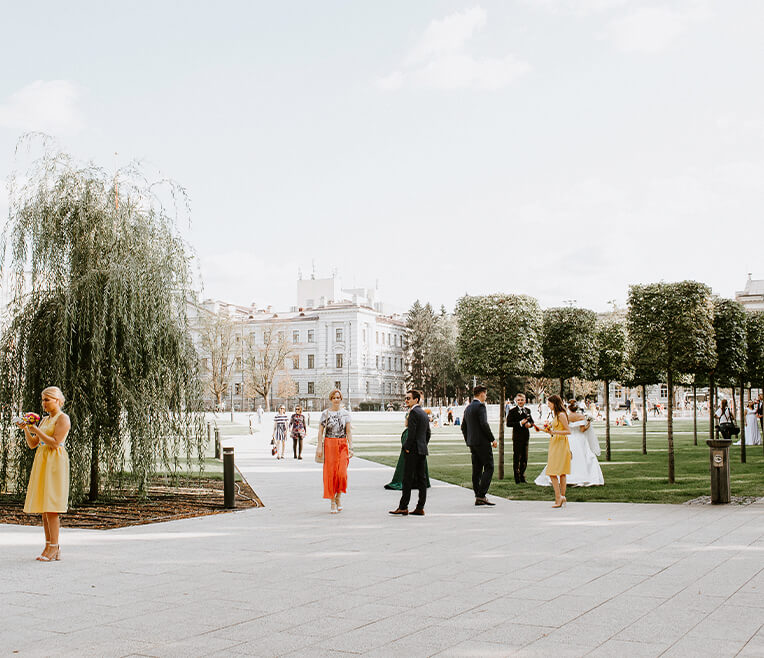
The history of demonstrations – from the 1960s to the digital age
A demonstration (from the Latin »demonstrare«; to show, point, and/or prove) is interpreted from a sociological point of view as a symbolic action. Since the Enlightenment, the street has become a powerful public sphere, a space of democracy where opinions can be negotiated and political messages presented. As early as 1848, 500 students demonstrated in protest against reactionary politics at the Wartburg Festival. However, demos did not become a mass phenomenon until the 1960s. A brief outline.
- Text: Barbara Eichhammer
The »street is our mass media«, the writer Peter Weiss announced in 1968 in West Berlin before a demonstration against the Vietnam War. The street was established as a place for the democratic dissemination of opinion at public gatherings. From a sociological point of view, a demonstration (from the Latin »demonstrare«) is regarded as a symbolic act. Since the Enlightenment, the street has served as a powerful place for the bourgeois public, a space of democracy where opinions can be freely negotiated, civil rights demanded, and political messages displayed. As early as 1848, students protested against reactionary politics at the Wartburg Festival. However, demos did not become a mass phenomenon until the 1960s. A brief outline.
The 60s: The civil rights movement in the United States
The origin of demonstrations as popular mass phenomena arose with the civil rights movement in the United States, which fought for the equal rights of African Americans. Slavery had been abolished in the USA since the end of the American Civil War in 1865, but legal segregation meant African Americans remained oppressed in the Southern States. Designated seats in buses or separate toilets for whites and blacks were part of everyday life. Under the leadership of Martin Luther King Jr., the »March to Washington for Jobs and Freedom« took place on 28 August 1963, which is considered one of the most important events of the American civil rights movement. The demonstration saw more than 200,000 people of all races gather for a peaceful protest in front of the Lincoln Memorial in Washington, D.C. Martin Luther King Jr. gave his famous »I Have a Dream« speech at the event, outlining his vision of an equal coexistence between whites and blacks. Nonviolent resistance with civil disobedience was the maxim. And the movement was successful: The march led to the adoption of the Civil Rights Act of 1964, which abolished legal racial segregation.
The Vietnam War & counterculture
»How many years can a people exist, before they’re allowed to be free?«, Bob Dylan, Blowin’ in the Wind
The mood in the United States during the 1960s was not just fuelled by domestic politics. Foreign policy conflicts such as the Vietnam War also ignited protests. Bombing North Vietnam without a declaration of war and the use of chemical weapons strengthened calls for peace. Around 100,000 young people – most of them men – demonstrated at the »March on the Pentagon« in Washington D.C. on 21 October 1967. They called for the unconditional withdrawal of the U.S. military from Vietnam. Many burned their military passports and draft orders. The demonstration was a turning point: The thousands of young American men who refused military service strengthened the anti-war movement around the world. The counterculture of the hippie movement, which deliberately resisted societal conventions and followed the slogan »make love, not war«, furthered the cause. Promoting world peace, free love, recreational drug use, Eastern religions, and sexual freedom were just some of the key aspects of this new liberal lifestyle.
The student protests of 1968
Like their fellow students in the USA, young Germans also demanded an end to the Vietnam War. The »68ers« disrupted university events and blocked road traffic through peaceful sit-ins, which led to a more equitable university reform. They broke with bourgeois conventions by resorting to the left-liberal and neo-Marxist theories of the Frankfurt School and American hippie movement. Sexual freedom and casual dress were the order of the day. Most of all, they countered the conservative image of the »nuclear family« of the 1950s. Incidentally, critics saw this attitude as contributing to higher rates of divorce. The 1968 movement was driven by the student association »Sozialistischer Deutscher Studentenbund« (SDS) with renowned representatives such as Rudi Dutschke, Dieter Kunzelmann, and Bernd Rabehl, who openly opposed the mainstream press. On Maundy Thursday of 1968, an assassination attempt on the Ku’damm in Berlin left the figurehead of the student movement, Rudi Dutschke, with a gunshot wound to the head that endangered his life and contributed to his death eleven years later. Journalists of the BILD newspaper had previously declared the sociology student, who had fled the GDR, »public enemy no. 1«.
The attack was a breaking point and saw the peaceful protest evolve into a student revolt. There were violent clashes in 27 cities during Easter of 1968. Tens of thousands of young people threw stones at the branches of BILD publishing house Springer and set their delivery vehicles on fire. The Easter Rising was among the largest demonstrations the young Federal Republic had seen. Almost four weeks later, the Grand Coalition’s planned state of emergency provided reason for further unrest. Although the emergency laws were supposed to guarantee the state’s ability to act in crisis situations, left-wing students feared that the government could restrict basic democratic rights. On 11 May 1968, around 60,000 people protested against the measures during a protest in Bonn. The student movement began to fizzle by 1969 as internal divisions formed. Some saw protest with weapons as an adequate response to political conflicts. This resulted in the emergence of terrorist groups such as the Red Army Faction (RAF). Other activists, such as Rudi Dutschke, founded the Alliance 90/The Greens party or, like Joschka Fischer, made it into the Bundestag.
The 70s: The anti-nuclear movement
In the seventies, in the wake of the oil crisis, an anti-nuclear movement formed against what an increasing number of people saw as way to harness energy. It stood for the phase-out of nuclear power plants and grew far beyond the political approaches of the traditional left-wing activists of 1968. The movement is also associated with the emergence of a young subculture that represented an environmentally conscious lifestyle. The world’s first successful anti-nuclear initiative actually began in California in 1958 and was aimed at stopping the nuclear power project at Bodega Bay, north of San Francisco. The historian Joachim Radkau sees the continuity of the German anti-nuclear movement as »the largest and most thought-provoking public discourse in the Federal Republic«. In just a short period of time, the movement succeeded in mobilizing large crowds. This is partly because the federal government took authoritarian action against mass demonstrations in Wyhl (1975), Brokdorf (1976/77), Kalkar (1977), Gorleben (1978/79), and Bonn (1979). The protests surrounding the Gorleben nuclear waste disposal site were especially notable: In the spring of 1979, around 100,000 people demonstrated in Hanover under the slogan »Gorleben should live«. Opponents of nuclear power prevailed with non-violence. In the 2000s, ecological protests caused a sensation on the streets. Be it the dispute over the Stuttgart 21 railway station (2009) or the ongoing opposition to coal mining in the Hambach forest (2018), sit-ins are still popular forms of protest today.
Demonstrations & Social Media
Demonstrations and public exchanges of opinion were given a new medium in the 2000s with the emergence of social media. The »Women’s March on Washington« is just one example that showed how much Twitter, Facebook, and the like can act as catalysts for a social protest movement. The Women’s March on Washington, D.C. on 21 January 2017, the day after President Donald Trump’s inauguration, was a demonstration for women’s and human rights. The movement started as a Facebook event: Teresa Shook of Hawaii considered statements made by Donald Trump to be hostile to women and racist, so after the presidential election on 9 November 2016, she organized a march against his policies. The result was record-breaking: About half a million people gathered in Washington alone. At the same time, there were solidarity marches in 670 cities around the world, including Paris, London, Berlin, New York, and Vienna.
Digital demonstrations: #MeToo
Social media has the potential to both improve and worsen social conflicts. In today’s digital world, public uprisings can start with little more than a hashtag. When actress Alyssa Milano used the hashtag #MeToo on Twitter in October of 2017 in the course of the Harvey Weinstein scandal, she triggered a worldwide debate on an unprecedented scale. Milano wanted to encourage women to use the hashtag to draw attention to sexual harassment in everyday life and reveal the scope of the problem. #MeToo went viral and trended in more than 85 countries. #MeToo is a rare example of the real-life impact of social media: While online tumult doesn’t always spur political action, the hashtag made it to the European Parliament. In Germany, for example, #MeToo led to the founding of the »Trust Centre Against Sexual Harassment«. The problematic side of social media was shown by the 2018 Chemnitz riots, where false rumours circulating online after a civic festival played a major role in mobilizing right-wing extremists to stage violent pursuits. Social media repeatedly clashes against the limits of free speech, making it all the more important to differentiate between fake news and the truth in 2019.






